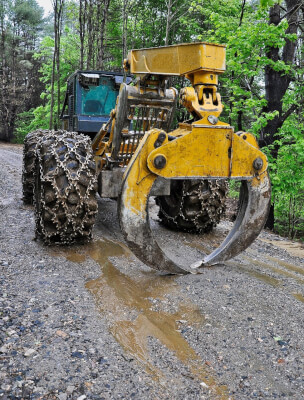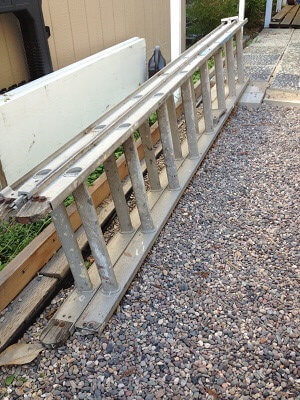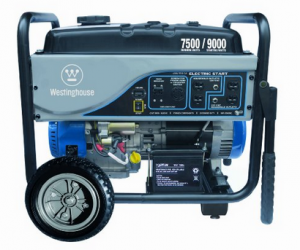Emergency Tools are Critical to Survival
Bare hands won’t work.

Clearing roads, walkways and corridors, prying open locked or distorted doorways, freeing victims pinned beneath fallen debris — just a few of the scenarios you might experience in an emergency. You’ll want the right emergency tools in your hands — and you’ll want to protect those hands!
So the solution? Heavy, well-fitting gloves!
This is particularly important for women, because most off-the-shelf gloves — even those provided via a CERT class — are JUST TOO BIG. If you’ve been visiting here a while, you’ll have seen some of our gloves. They make for good photos, but the extra space across the palm and at the end of my fingers means I just can’t wear them. In the presence of tools they are just plain dangerous!
The image at the left shows some of the gloves I do like for myself. Heavy-duty construction. Leather. Separation between fingers. Elastic at wrist. And you can select SMALL.
Whatever size you wear, find good ones and get several pairs. In wet or heavy work, you can damage them or even just wear them out. Here’s the link to Amazon so you can take a look for yourself.
OZERO Leather Work Gloves Flex Grip Tough Cowhide Gardening Glove for Wood Cutting/Construction/Truck Driving/Garden/Yard Working for Men and Women 1 Pair (Gold,Medium)Essential emergency tools for turning off utilities.
Water shut-off.
In an earthquake or storm, you may face broken pipes — somewhere in the system or even inside your house. (Remember those terrible photos from the ice storm in Texas?) If you don’t know where or how to shut the water off, every minute increases the chance of damage or even danger.
Do you know where ALL THREE water supply shut-offs are located?
An Individual appliance may have its own shut-off valve. Check the water lines leading to the toilet, for example. Easy enough to shut off.
Turning off water to the whole house can keep water in your tank from becoming contaminated! Your home has a master shut-off valve. It’s usually in the basement, crawl space or maybe in the garage. It may be located outside by the foundation. These valves usually can be shut off by hand — just turn the faucet handle (clockwise) or the lever (until it’s crosswise to the pipe).
You may also want to turn off water at the street. This valve is probably buried in a concrete box some distance from the house. Use a big screw driver to pry off the cover. (Gloves, here!) Then use a special water shut-off tool that has a sort of hook at the bottom. (You may have used one for your irrigation system.)
Here’s an article with a number of illustrations that may be useful.
ACTION STEP: Plan a time for a family tour to find all your water shut-off valves! Do you need an emergency tool to turn any of them off? (See below for a suggestion.)
Natural gas shut-off.
Here where I live our scariest danger is fire after an earthquake. Fire fueled by gas leaking from broken gas lines! So on a regular basis our neighborhood group puts out information about where and how to turn off the gas if you smell that rotten egg smell!
Just like water, there are a variety of valves to shut off the gas. At the street (distribution pipe), in the neighborhood (smaller pipes) and directly to your home (low pressure pipe). Generally, you can only control the line that leads into your home.
You’ll need a sturdy wrench or specialty tool to turn off the gas! And you’ll need to know HOW to turn if off. (See below for a gas wrench suggestion.)
ACTION STEP: Find your gas shut-off valve. Store a gas shut-off wrench permanently near the valve.
DO NOT PRACTICE shutting off the gas! Once it’s off, you’ll need the gas company to come turn it on again! (All pilot lights will have gone out, remember . . .)
A convenient, all-in-one tool for shutting off water and gas.
Get at least one, have a permanent place for it so it doesn’t go missing. Know you’ll be ready when you need to use it!

Will you be able to use your power tools?
The image at the top of the page shows a standard power tool. But when you’re planning for an emergency, you have to assume that power will be out. So what are your options?
Battery-driven tools (power drills, chain saws) will have a limited useful life span if they can’t be re-charged. These days, many tools come with multiple change-out battery packs, which gives the tools a lot longer useful life span. And there are small Power Banks for small devices. Still, at some point, batteries will run out. So to be useful, they’ll have to be recharged.
What are your recharge options for emergency tools?
- Some people and businesses keep gasoline or butane-powered generators to supply emergency power. They can be really useful — but generally, they’re big, heavy and noisy. And they can be dangerous.
- If you live in the right location, and can afford it, you may want to consider using a solar system to charge your tools. Solar works well for small-ish devices and lighting, but it takes a big system to actually drive anything with a motor.
- Power inverters can take the output of a 12-volt battery and convert it to 110 volt AC, but in an emergency you’ll probably want more power than your inverter can give you. Still, worth another look.
Here’s an updated discussion of generators and inverters.
What about emergency lighting?
And let’s not overlook lights as emergency tools! Without them, you won’t be able to do much with the other tools you may have that still work!
Small flashlights are appropriate for getting around in the dark but may not provide adequate lighting for working in an emergency situation. Some newer flashlights offer more options, fortunately. Some have a side panel of lights, not just the main light. Some have magnets that can stabilize the light so you have both hands free. Flashlights are essential emergency tools — as long as their batteries hold out.
Lanterns can be even more useful, since you can set them down while you work. Low-level lighting is adequate for moving around in a space, and many lanterns adjust to meet that purpose. Other lanterns even have red or blinking emergency signals. From an emergency standpoint, it makes sense to have a couple of solar-powered lanterns, too, since batteries will ultimately fail.
Headlights from cars or trucks often suffice, but they may not be able to maneuver into position to be of help in all situations. There are large battery-operated candlepower spotlights available that can overcome this challenge, but most people don’t have these on hand. And again, they ultimately run out of juice.
Emergency lights keep getting better and better. Here’s our latest review of heavy duty lanterns. And for power tools that will last, take a look at this Advisory about solar-powered lights and tools.
What tools do you need to add to your emergency supplies?
ACTION STEP: Start now to put together an inventory of what emergency tools you have on hand, and what tools are available in the neighborhood. Make sure you have the essentials. Consider whether an auxiliary power source will be required for tools to be effective.
Joe Krueger
Your Emergency Plan Guide Team








